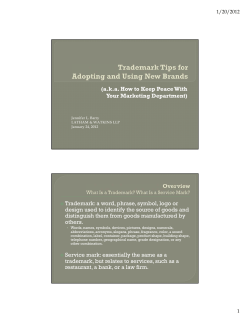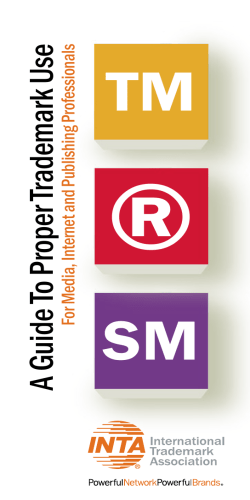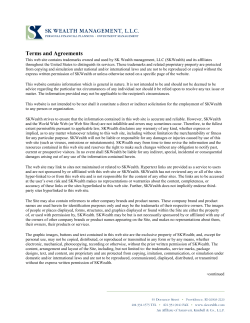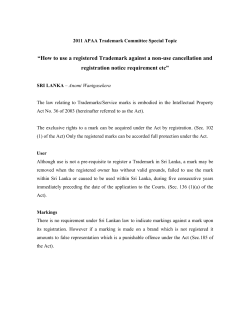
European trademarks reform: why do we need it ė
European trademarks reform: why do we need it Lina Mickienė Deputy Director State Patent Bureau of the Republic of Lithuania AIPPI conference Vilnius, April 12, 2013 www.vpb. gov.lt European trademarks: facts and figures Value of the top ten brands per one EU country amounts to almost 10% in relation to their GDP (PPP) and € 35 billion per Member State but amounts to € 145 billion in Germany and € 138 billion in the UK* Annual communication and advertising expenditure in Europe on brands of € 174 billion benefits media as well as sport, arts and entertainment 48% of EU exports are upmarket branded goods** The total number of trade mark applications in the 27 current EU Member States increased by about 8% from 471,000 in 1996 to 509,000 in 2008*** The numbers of CTM applications have more than doubled during a similar period from about 43,000 in 1996 to over 107,000 in 2012*** By the end of 2012, OHIM registered almost 900,000 CTMs and, in October 2011, the one millionth CTM application was filed*** * Source: European Brand Institute, www.eurobrand.cc. ** Source: http://www.aim.be/economic_aspects.htm *** Source Commission Impact assesment (doc. 8065-13 Add1) www.vpb. gov.lt 2 One-millionth Community trademark application was filed by Lithuanian entity UAB „Valentis“, trademark “CIGNON”s www.vpb. gov.lt 3 European trademarks system legal framework Directive 89/104/EEC of 21 December 1988, to approximate the laws of the Member States relating to trade marks (codified as Directive 2008/95/EC) Council Regulation (EC) No 40/94 of 20 December 1993 on the Community trade mark, codified as Regulation (EC) No 207/2009 Implementing acts of the Commission: Commission Regulation (EC) No 2868/95 of 13 December 1995 implementing Council Regulation (EC) No 40/94 on the Community trade mark Commission Regulation (EC) No 2869/95 of 13 December 1995 on the fees payable to the Office for Harmonization in the Internal Market (trade Marks and Designs) Commission Regulation (EC) No 216/96 of 5 February 1996 laying down the rules of procedure of the Boards of Appeal of the Office for Harmonization in the Internal Market (Trade Marks and Designs) National trademark laws International treaties on trademark protection www.vpb. gov.lt 4 CTM owners by company size www.vpb. gov.lt 5 Internal Market and Services Commissioner Michel Barnier March 27, 2013 said „Trade marks were the EU’s first success in intellectual property rights. The harmonisation of Member States' laws in 1989 and the creation of the Community trade mark in 1994 paved the way for other tools for intellectual property protection, such as design protection and the unitary patent. Today, 20 years later, I am very proud to announce that our trade mark system has stood the test of time. There is no need for a major overhaul: the foundations of our system remain perfectly valid. What we are aiming for is a well-targeted modernisation to make trade mark protection easier, cheaper, and more effective“* * Source http://europa.eu/rapid/press-release_IP-13-287_en.htm www.vpb. gov.lt 6 Political background for the reform 21 and 22 May 2007 Council Conclusions on Financial Perspectives of the Office for Harmonisation in the Internal Market (Trade Marks and Designs) and the further development of the Community trade mark system – invitation to the Commission to start work on a comprehensive study on the overall functioning of the CTM system (doc. 9427/07) 2008 Commission communication “Think Small First” - A “Small Business Act” for Europe (doc. COM(2008) 394 final) 2008 Commission communication on an Industrial Property Rights Strategy for Europe (doc. COM(2008) 465 final) 2010 Commission communication on Europe 2020 strategy (doc. COM(2010) 2020 final) 2010 Commission IPR strategy for Europe (doc. COM(2011) 287 final) 25 May 2010 Council Conclusions on the future revision of the Trade Mark system in the EU – call to the Commission to present proposals for the revision of, respectively, the CTM Regulation, and the Directive approximating the laws of Member States relating to trade 7 marks (doc. 2010/C 140/07) www.vpb. gov.lt Comprehensive Max Planck study Comprehensive study commissioned by the Commission from the Max Planck Institute for Intellectual Property and Competition Law in Munich, Germany Carried out between November 2009 and February 2011 Study comprised a number of consultations with various stakeholders: large online survey among users of the CTM system was performed by the Institut für Demoskopie Allensbach, Germany (Allensbach survey) user associations were invited to express their views on all evaluation questions, and to make further observations and suggestions a hearing with 15 major user organisations was organised by the Max Planck Institute in Munich on 8 and 9 June 2010 all national IP offices and OHIM, most of them by means of personal visits, the rest on the basis of a written questionnaire were consulted www.vpb. gov.lt 8 Main Max Planck study conclusions Basic features of the European TM system – characterised by the coexistence of the CTM and national TM protection, supplemented by the international registration system to which the EU and its MS belong – have proven themselves in practice and no major legislative amendments or reforms are necessary The survey results make clear that the national systems serve an important complementary function for the CTM system and that maintaining them is in line with the interests of all users of the European trade mark system, also the users of the CTM system Convergence of laws and practices in the EU is necessary in order for TM protection to continue to be an essential element in the competitive market economy of the EU Large set of proposals to update and further develop the system as a whole with a particular focus in increasing its overall coherence and reinforcing the principle of coexistence were proposed www.vpb. gov.lt 9 COMMISSION STAFF WORKING PAPER IMPACT ASSESSMENT* General objective - to modernize the trademarks system in Europe 2 problems are indicated: Divergences of law (missing substantive and lack of any procedural rules) Insufficient level of cooperation between OHIM and national offices (vague legal base, insufficient technical and financial capacity) 2 fundamental conclusions can be made: CTM law doesn’t replace Member states Trademarks laws but provides additional legal framework for TM protection and -Coexistance does not mean that CTM and national systems merely exist in parallel but they should complement each other harmoniously, that is, in a way that allows each system to attain its specific purpose * Commission doc. 8065-13 Add1, Brussels, 2 April, 2013, COM presentation 10/04/2013 www.vpb. gov.lt 10 Proposals by the Commission 27 March, 2013 Commission announced European trademarks reform package: Recast of the Directive of the European Parliament and of the Council to approximate the laws of the Member States relating to trade marks (doc. COM(2013) 162 final) Amendments to the Regulation of the European Parliament and of the Council amending Council Regulation (EC) No 207/2009 of 26 February 2009 on the Community trade mark (doc.COM(2013) 161 final) ! Proposal of Commission Regulation amending Regulation (EC) No 2869/95 on the fees payable to the Office for Harmonization in the Internal Market (Trade Marks and Designs) and Regulation (EC) No 2868/95 implementing Council Regulation (EC) No 40/94 on the Community trademark www.vpb. gov.lt 11 Key features of the revision Political institutional changes: adapting legislation to Lisbon Treaty and new inter-institutional Common Approach on decentralized agencies Legal changes: modernization of existing provisions and increasing legal certainty and incorporating ECJ case law greater approximation of substantive laws streamlining and harmonizing registration procedures introducing procedural rules into the Directive, taking the Union (CTM) system as benchamarks Administrative financial changes: facilitating cooperation between OHIM and national industrial property offices balancing OHIM budget www.vpb. gov.lt 12 Political institutional changes (Regulation) Terminology: Community trademark → European trademark (Art. 1) OHIM → European Union Trade marks and designs Agency (Art. 2) President of OHIM → Executive Director of the Agency (Art. 128) Community trade mark court → European trade mark court (Art. 1) Modernizing OHIM governance rules for more transparency and accountability - strengthening role of the Administrative Board (Art. 124): Powers of the appointing authority Formal adoption of the annual and multi-annual work programme (including strategy on international cooperation) and of the annual report Alignment of the “comitology” powers conferred upon the Commission to Article 290 of the Treaty New articles - 24a, 35a, 45a, 49a, 57a, 65a, 74a, 74k, 93a, 114a, 144a, 161a) Delegated acts adopted by the Commission shall enter into force only if no objections either by the European Parliament or the Council 13 2 months + 2 months www.vpb. gov.lt Legal provisions – modernising legal system, implementing ECJ decisions. Regulation and Directive Definination of trademark graphical representabilty replaced by more flexible criteria (Art 4 Reg and 3 Dir) ← ECJ C-273/00, C-283/01, T-305/04 Rights conferred by a trademark (Art 9 Reg, 10 and 11 Dir) are detailed: Without prejudice to prior rights ← TRIPS Art. 16(1) Use as a trade or company name ← ECJ C-17/06 Use in comparative advertising ← Directive 2006/114/EEC Art. 4. ECJ C-487/07 Consignments from commercial suppliers ← ECJ C-405/03, C-281/05 Goods placed under a suspensive procedure ← ECJ C-446/09, C-495/09 Preparatory acts ← national best practise Limitation of effects of a trademarks (Art. 12 Reg, 14 Dir) – use of personal name ← ECJ C-533/06 Certification mark is introduced (Art. 74b-74k Reg, 28 Dir) – national best practice Protection of geographical indications and traditional terms (Art.7 Reg, 4-5 Dir) ← Regulations 510/2006, 1234/2007, 110/2008 Protection of marks with reputation (Art. 5 and 10 Dir) ← harmonization with Reg., ECJ C-292/00 Trademarks as objects of property (Art. 22-27 Dir) ← harmonization with Reg. Collective marks (Art. 28, 30-37 Dir) ← harmonization with Reg. Designation and classification of goods and services (Art. 28 Reg. and 40 Dir) ← ECJ C-307/10 14 www.vpb. gov.lt Alignment of principal procedural rules in national laws. Directive* Ex officio examination limited to absolute grounds for refusal (Art. 41) 12 Member states are conducting examination on relative grounds Observations of third parties (Art. 42) (not possible in Lithuania) Mandatory administrative opposition procedure (Art. 45) Mandatory administrative cancellation and invalidation procedure (Art. 47) (doesn‘t exist in Lithuania) Non use as defence in opposition proceedings and as defence in proceedings seeking a declaration of invalidity (Art. 46 and 48) Rules on duration of protection and renewal (Art. 51) Fees – “on-class-per-fee” system, allowing more targeted registration per product class for a proportionate fee (Art. 44) (Lithuania applies) * More information about status quo in Member States, Max Planck study http://ec.europa.eu/internal_market/indprop/docs/tm/20110308_allensbachstudy_en.pdf 15 www.vpb. gov.lt Streamlining procedures in the Regulation Filing of applications (Art. 25 ) – filing via national offices abolished Filing date (Art. 27) – obligation to pay the fee linked with the filing (onemonth period abolished) Searches (Art. 38, 155) - abolished, to be replaced by modern IT search tools Publication of the application (Art. 39) – abolishment of 1 month related to search report (speeding up of the registration procedure) Observations by 3rd parties (Art. 40) – extension from the filing period (after publication on CTM online) Revision of decisions inter partes (Art. 62) – abolished as not used in practice Continuation of proceedings (Art. 82) - detailed Opposition period for international registrations (Art. 156) – 6 months shortened to 1 month www.vpb. gov.lt 16 OHIM financing Financial autonomy of OHIM is confirmed Principal of balanced budget is strengthened (Art 144 (2) Transfer of generated surplus to the general EU budget is foreseen, if decisions to regulate Agency budget are not founded (Art 144 (2) Mandatory review of the fees via delegated power to the Commission to adopt, review fees regulations (Art 144a, 165a (2) Commission proposal to amend Regulation (EC) No 2869/95 on the fees payable to OHIM - changes in fees structure: “on-class-per-fee” system for filing and renewal, including collective marks and individual fees for international registration designating the European Union special discount for applicants using online classification database differentiation of fees per classes (1st, 2nd, 3rd and more) www.vpb. gov.lt 17 New fees proposed the Commission Fee Individual mark Collective mark Basic Renewal Basic 925 1150 1000 Application filed 775 by electronic menas/renewal 1000 For the application Application filed 725 by electronic means and using the online classification database second class of goods and services third class of godos and servines Fee for each class of goods and’ services exceeding three www.vpb. gov.lt Renewal International registrations (individual mark) Basic Renewal International registrations (collective mark) Basic Renewal 1275 725 950 950 1225 950 50 100 50 100 50 100 50 100 75 150 75 150 75 150 75 150 150 300 150 300 150 300 150 300 18 New framework for cooperation (Art. 123c of the Regulation) Legally and financially solid, result oriented mechanism Mandatory cooperation to promote convergence of practice and tools, coordinated by Agency (...shall cooperate... shall participate...shall finance...) Broadly defined areas of activity (from development of common examination standards, creation of common or connected databases to ... establishment of common standards and practices, exchange of technical expertise and assistance) Funding based on grants Grants without calls for proposals (all offices to participate) Lump sum payments, as appropriate (e.g. to cover running costs) Limited circle of beneficiaries of the funding – only industrial property offices of Member States and the Benelux Office for the Intellectual Property Up to 10% of yearly income of the Agency(= 17-20 million) www.vpb. gov.lt 19 Existing cooperation practice between OHIM and national industrial property offices Bilateral cooperation agreements: Aim - financing of specific information and advice services related to the CTM. May also cover costs related to fairs, exhibitions and publications as well as organisation of seminars, workshops etc. First started in 2005 when 13 offices participated (2013 - 26 offices participate) Max 100 000 euro per year for each Member State Based on prinicipal of coofinancing – 80 % financing from the OHIM, 20% - by the national office www.vpb. gov.lt 20 2006 - 2011 bilateral cooperation = OHIM contribution with 8.956.915,33€ (“payments done”)* NATIONAL OFFICES 2006-2011 %Budget Execution 1. Austria €488,274.32 5.45% 2. Bulgaria €99,979.28 1.12% 3. Benelux €1,107,815.27 12.37% 4. Cyprus €606.05 0.01% 5. Czceh Republic €153,036.10 1.71% 6. Denmark €918,183.00 10.25% 7. Estonia €30,727.00 0.34% 8. Finland €263,552.11 2.94% 9. France €916,146.05 10.23% 10. Germany €589,182.47 6.58% 11. Greece €58,271.28 0.65% 12. Hungary €650,975.57 7.27% 13. Ireland €104,660.84 1.17% 14. Italy €257,512.11 2.88% 15. Latvia €9,442.89 0.11% 16. Lithuania €74,918.56 0.84% 17. Malta €237,486.00 2.65% 18. Poland €288,169.82 3.22% 19. Romania €242,884.77 2.71% 20. Portugal €796,078.94 8.89% 21. Slovakia €95,457.88 1.07% 22. Slovenia €220,571.68 2.46% 23. Spain €450,184.51 5.03% 24. Sweden €306,480.86 3.42% 25. UK €596,317.97 6.66% TOTAL €8,956,915.33 * Source OHIM information www.vpb. gov.lt 21 www.vpb. gov.lt 22 Existing cooperation practice between OHIM and national industrial property offices (cont.) European trademark and design network https://www.tmdn.org/coopfund/ Cooperation Fund Aim - to promote further harmonization, modernise national IP offices, and make things easier for users of the European trade mark and design systems Was agreed in 2008 by OHIM Administrative Council and Budget Committee Allocation of €50 million until 2015 100% of expenses are covered by the Fund A total of 16 initiatives are going ahead under the Fund Related activities Multilateral cooperation projects – TMview and Euroclass www.vpb. gov.lt 23 Cooperation Fund projects 1.1.1 Search Image 1.2.8 Designview 1.1.2 TMview 1.2.9 Similarity 1.1.3 TM Class 1.2.10 Cesto 1.1.4 Seniority 2.13 XML Standards & Arch. 1.2.5 Quality Standards 3.20 E-Learning 1.2.7 User Satisfaction Survey Packet 1:- Approval of Project Brief in October 2010, - Kick-off in January 2011 www.vpb. gov.lt 24 CF Projects - 2 1.2.11 Common Gateway 3.21 Call Centre Tool 1.2.6 Forecasting 4.22 Enforcement Database 2.14 Future Software Package 4.23 Counterfeiting Tool Packet 2:- Approval of Project Brief in April 2011, - Kick-off in September 2011 www.vpb. gov.lt 25 = total intents (324) = total implementations (130) Number of national offices 30 2626 25 2525 25 Source OHIM CF information 23 22 22 21 19 20 19 18 18 16 19 19 18 18 15 15 13 12 10 10 8 6 5 5 3 2 1 0 www.vpb. gov.lt 26 Existing cooperation practice between OHIM and national industrial property offices (cont.) Convergence programme Aim - to try and reach common ground on a series of issues where IP offices in the EU have different practices. Participants – OHIM, national offices and user organizations Launched in 2011 5 convergence initiatives: Harmonization on Trade Marks Classification Practice of G&S Convergence of Class Headings Relative Grounds – Likelihood of Confusion Absolute Grounds - Figurative Marks Scope and protection of B&W Marks Related activities Multilateral cooperation projects – TMview and Euroclass www.vpb. gov.lt 27 Cooperation between the State Patent Bureau of the Republic of Lithuania and OHIM Cooperation started in 2004 Representatives of the SPB represent the Republic of Lithuania at Administrative Council, Budget Committee, joint meetings of the Administrative Council and Budget Committee Experts of the SPB attend technical cooperation meetings, Liaison meetings of OHIM and representatives of national offices regarding the matters concerning trademarks and designs, employees of SPB participate in trainings organized by OHIM Every year about 6 Lithuanian judges are trained in OHIM seminars for judges First bilateral technical cooperation agreement was signed in 2010 Since 2010 implementation of Cooperation fund projects www.vpb. gov.lt 28 OHIM Cooperation Fund Projects in Lithuania Implemented and undergoing projects CF 1.1.2 TMview (implemented in 2011, yearly ) TM-XML standart extension (participation of IT specialist in 2011) CF 1.1.4 Seniority (implemented in 2012) CF 1.1.3 Classification G&S (since 2011) CF 1.2.11 Common gateway (implemented in 2012) CP1 –CP5 Convergence program projects (since 2011) For year 2013 are foreseen CF 1.1.1 Search Image CF 1.2.8 Designview CF 2.14 Future software package CF 1.2.5 Quality standards www.vpb. gov.lt 29 Conclusions... Trademarks are largely used IPR object in the EU market and over the world Due to the territorial character and great value the adequate protection for trademarks should be guaranteed on all levels – national, regional and international European trademark reform is timely after more than 20 years successful climbing into the free market hill European trademark system works properly nevertheless new technologies, jurisprudence, practical experiences, convergence of national and Community systems inspire some changes The main principal should be followed - national systems serve an important complementary function for the CTM system and that maintaining them is in line with the interests of all users of the European trade mark system, also the users of the CTM system European trademark reform announced on March 27, 2013 is one of the priorities of upcoming in few months Lithuanian Presidency of the European Council www.vpb. gov.lt 30 Thank you for your attention Lina Mickienė Deputy Director State Patent Bureau of the Republic of Lithuania Tel. + 370 5 278 0252 E-mail [email protected] www.vpb. gov.lt 31
© Copyright 2025











